link to page 1 link to page 2 link to page 2 link to page 3 link to page 3 link to page 3 link to page 4 link to page 4 link to page 5 link to page 5 link to page 6 link to page 6
 Appendix C - Documents released
Outlook Quickparts used by the Central OIA inbox
Appendix C - Documents released
Outlook Quickparts used by the Central OIA inbox
The below wording is in use by the Central inbox. Please feel free to adopt any of these email
templates you choose. Note however some wording in our quickparts is only included on a case by
case basis. You will need to read carefully and decide whether all content is appropriate to your
circumstances, and delete parts you do not need
Contents
•
Acknowledge OIA
•
Allocate OIA
•
Clarify/refine request scope
•
Confirm clarified/refined request
•
Consult with agency on transfer
•
Notify requester of transfer
•
Confirm transfer to the agency
•
Notify transfer to the agency w/o consultation
•
Notify/consult third party on request that includes their information
•
Extend request timeframe
•
Notify requester of decision
•
Redirect Archives NZ research request
Acknowledge OIA
under the Official Information Act 1982
Tēnā koe x,
Thank you for your OIA request to the Department of Internal Affairs (included with this email)
The Department will provide its response to your request as soon as practicable and within twenty
working days. The 20th working day is XX
Please note that in cases where the Department’s response provides information that is identified to
be of general public interest, the response may also be published on the Department of Internal
Released
Affairs website. If the Department publishes its response to your OIA request, all personal
information, including your name and contact details, will be removed.
Ngā mihi
Allocate OIA
Tēnā koe x,
The Department has received the below request.
Please reference OIAXX in your response, which is due to the requester by XX
Acknowledgement is attached
Acknowledgement sent by business unit
Ngā mihi
Clarify/refine request scope
Tēnā koe x,
Thank you for your OIA request to the Department of Internal Affairs (included with this email)
You have requested:
•
X
To be able to assist you further with your request, we need to find out more about the particular
information you are seeking.
[question]
Or
Statement about the volume of info potentially in scope, or the volume of information that would
need to be searched to be able to identify the information.
The scope of your request would require the Department to undertake substantial collation and
research to able to answer it, and this would be likely to disproportionately impact the normal
operation of the Department. We have considered whether extending the timeframe for response
under the Official Information Act 1982
or fixing a charge would enable your request to be answered, however neither option is suitable as
the time needed cannot be accurately estimated. For this reason, the Department is considering
refusing your request.
I am contacting you in order to give you the opportunity to refine your request to enable it to be
answered without substantial collation and research.
[suggestion if applicable]
Released
Please contact the Department as soon as possible to advise whether you would like to refine your
request scope. If we do not receive response from you by XX, a decision will be made on your
request, and this may result in your request being refused.
If you would like to discuss your request with us by phone, you are able to contact X at X
Ngā mihi,
Page 2 of 6
Confirm clarified/refined request
Tēnā koe x,
Regarding your OIA request to the Department of Internal Affairs, discussed with you on XX, our
understanding of your request is:
XX
If we have not correctly understood your request and you would like us to amend it, please let us
know by responding with the corrected wording of your request.
Please note that your amended/clarified request is being treated as a new request replacing the
original, in accordance with section 15(1AA) of the Official Information Act 1982. The timeframe for
response changes accordingly.
The Department will provide its response to your request as soon as practicable and within twenty
working days. The 20th working day is XX
Ngā mihi,
Consult with agency on transfer
Kia ora koutou x colleagues,
The Department of Internal Affairs has received the attached request and is proposing transfer of this
request to your agency for response.
Transfer is in accordance with section 14(b)(i) and (ii) of the Act. The information requested is not
held by the Department of Internal Affairs, but we believe it is held by, and more closely related to
the functions of XX
Please confirm whether you accept transfer of this request, or advise reasons why this request
should not be transferred.
If transfer is accepted, we will notify the requester of the transfer and will forward a copy of this
under the Official Information Act 1982
notification to you.
I am available to discuss this transfer if helpful.
Ngā mihi,
Notify requester of transfer
Released
Tēnā koe x,
Thank you for your OIA request to the Department of Internal Affairs (included with this email)
Page 3 of 6
As the information you have requested is not held by the Department of Internal Affairs, but is
believed to be held by, and more closely related to the functions of XX, we are transferring your
request to that agency for response, in accordance with section 14(b) of the Official Information Act
1982.
You can expect to hear from the receiving agency shortly in regard to your request.
If you would like to contact them directly, you are able to email them at the following addresses:
XX
You have the right to seek an investigation and review by the Ombudsman of this decision to
transfer. Information about how to make a complaint is available at
www.ombudsman.parliament.nz or Freephone 0800 802 602.
Ngā mihi,
Confirm transfer to agency
Cheers x,
I confirm this request is now transferred to XX in accordance with section 14(b) of the Act.
I attach the original request and notification of transfer sent to the requester.
You have the right to seek an investigation and review by the Ombudsman of this decision to
transfer. Information about how to make a complaint is available at
www.ombudsman.parliament.nz or Freephone 0800 802 602.
Ngā mihi
Notify transfer to agency without consultation
Kia ora koutou X colleagues,
The Department of Internal Affairs has received the attached request, addressed to X and is
under the Official Information Act 1982
transferring this request to your agency for response.
Transfer is in accordance with section 14(b)(i) and (ii) of the Act. The information requested is not
held by the Department of Internal Affairs, but we believe it is held by, and more closely related to
the functions of X
I attach the original request and notification of transfer sent to the requester.
You have the right to seek an investigation and review by the Ombudsman of this decision to
Released
transfer. Information about how to make a complaint is available at
www.ombudsman.parliament.nz or Freephone 0800 802 602.
Ngā mihi
Page 4 of 6
Consult third party on information release
Tēnā koe X,
The Department of Internal Affairs (Department) has received a request for information under the
Official Information Act 1982 which includes in its scope some information that relates to you, and
which XX be released as part of the Department’s response to the request.
This information includes: XX
or
I attach the information that relates to you that falls within the scope of the OIA request.
The Official Information Act 1982 requires government agencies and entities to release any official
information that they hold, unless good reason exists to withhold the information unde
r section 6,
section 7 o
r section 9 of the Act. It also requires that, if any reasons to withhold may exist under
section 9 of the Act, the agency also consider whether there may be a greater public interest in
releasing the information.
If advising
We have reviewed the information and have identified no good reason under the Act for the
information to be withheld in this case.
We have reviewed the information and have identified that while a reason to withhold the
information exists under section 9(2)XX of the Act, there is a strong public interest in releasing the
information, in order to increase the transparency and accountability of government or to enable
better public participation in the activity of government.
It is anticipated that this information will be released on XX. If you have any questions or feedback
about this information release, please do not hesitate to emai
l [email address]. If you would like to
discuss this release by phone, you are also able to contact NAME at PH.
If consulting
If you have any questions about the release of the information that relates to you, or if you would
like to provide feedback or information to assist the Department to make its decision regarding the
release of this information, please respond by no later than XX.
under the Official Information Act 1982
If you would like to discuss this request with us by phone, you are also able to contact NAME at PH
Ngā mihi,
Extend request
Released
Tēnā koe x,
I am contacting you to advise that the Department of Internal Affairs is extending the timeframe
available for response in your request under section 15A(1)(a) of the Official Information Act 1982, as
substantial collation and research is necessary to be able to answer your request.
Page 5 of 6
I am contacting you to advise that the Department of Internal Affairs is extending the timeframe
available for response in your request under section 15A(1)(b) of the Official Information Act 1982, as
consultations necessary to make a decision on your request are such that the request is not able to
be completed within twenty working days.
The response timeframe is being extended by X working days. The Department’s decision on your
request will be provided to you as soon as practicably and no later than XX.
Ngā mihi
Issue Decision/interim response/final response letter
Tēnā koe x,
Please refer to the attached correspondence, which provides the Department’s decision on your OIA
request.
Ngā mihi,
Redirect requester to make Archives research request
Tēnā koe x,
The information you have requested is more than 25 years old and is therefore likely to be held by
Archives NZ. Official information that is transferred to Archives NZ, becomes part of Archives
collections and access is regulated by t
he Public Records Act 2005 rather than the Official
Information Act 1982.
You are able to search Archives NZ holdings using the Archway
portal
: https://www.archway.archives.govt.nz/
If you would like an Archivist to undertake a detailed search of the Archive to assist you with your
under the Official Information Act 1982
research, you are able to make a research request to Archives NZ. Please note that in some cases
there may be an associated charge. You can make a research request using this
webform
: https://archives.govt.nz/search-the-archive/get-help
Ngā mihi
Released
Page 6 of 6
Item arrives in the
Department of Internal Affairs central OIA inbox triage flowchart 1
OIA inbox
(training)
Item is asking for
Item is asking for
consultation or
general information,
feedback on
assistance or is a
something
business process
Create outlook folder in ‘Cross
Item is asking for
agency consultation’ as
official information
‘AGENCY - topic’
Create outlook folder in ‘media/
enquiries’ as ‘SURNAME - topic’’
Review key contacts
Log in OIA register.
and forward to any
Create outlook folder in ‘open’ as
parts of DIA that
‘19/20-xxxx SURNAME - topic’
may relate to topic
Update closing date in register,
(set timeframe for
Use quickparts
Held by DIA?
No – held by
enter outcome as transfer,
File in outlook
feedback clearly)
templates to
another agency/
Enter proactive release as N,
‘Transferred to
consult, notify and
body
Enter filing as filed in outlook,
agency’, by year
confirm transfer
For each part of
in comments enter ‘transferred to [agency]’
Don’t know.
request - Held by
YES
DIA?
NO
Receive feedback
Forward to OIA key
No – and not held by
Forward to agency/
and provide to
Refuse 18(e) or
END
contact for business
any other agency/
body as general
agency
18(g)
function as general
body either
correspondence and
correspondence and
confirm uplift
Review key contacts
confirm uplift
and consult across
File all
to confirm whether
Yes – information is
correspondence in
any information is
held BY dia
Reply to requester
folder and move
held
letting them know
folder to outlook –
that their email has
cross agency
been redirected to X
consultation –
Use agency list to
as the best agency/
completed, by year
consult across and
Send quickparts
body to assist them
confirm whether
acknowledgement
any information is
email to requester
held
END
Ensure all
correspondence is
filed in folder and
Send quickparts
move folder to
allocation email to
Outlook –
business unit
Media/
enquiries –
leading request
completed, by year
If request refined, OIA clock
restarted or request extended,
END
update in register.
under the Official Information Act 1982
Response is sent to
Response is being
OIA@dia to be sent
sent out by business
out by inbox and
group and bcc’d to
bcc’d to business
OIA@dia
unit
Update closing date in register, enter
outcome, proactive release Y/N, any
withholding grounds and whether filed in
repository
Released
Ensure all
correspondence is in
the filing folder and
move folder to
Outlook –
Completed, by year
ALL CORRESPONDENCE ON BEHALF OF THE INBOX SHOULD BE BCC TO THE INBOX AND FILED
IN THE FOLDER ASSOCIATED WITH THE ITEM, FOR ASSURANCE AND AUDIT PURPOSES
END
Department of Internal Affairs Central OIA inbox triage
flowchart 2 (training)
ENQUIRY RECEIVED
DON’T KNOW
Asks for documents or
Scope request
How many parts of
(business) info that require
I have no idea what this
Contact the
Log in OIA register
across Key OIA
DIA hold info
collation or consultation to
person wants!!
requester to clarify,
Contacts
decide on release
Asks for information that is
Respond directing
already publicly available
requester to
online
information
Send to the part of
None
One part
More than one part
Whole organisation
Get confirmation
General readily answerable
the Department
that the question
question about DIA business
that is able to
will be answered by
activity
answer OR send to
that business group
[email address]
Agree which part of
Send template
business will be
Acknowledgement
Asks for information about
Send to
leading response
email to requester
the requester, or correction
[email address]
of a record about the
Is it held by
requester
another agency
Book ½ hour
scoping meeting
with team if needed
Asks for an interview or a
Send to
Received directly by
media statement
[email address]
Inbox?
YES
NO
Use Transfer
Refuse under 18(e)
templates
Asks for permission to use an
Send to Contact in
NO
YES
image
National Library
Check with business
Send template
unit whether
Acknowledgement
Respond with:
request needs
Close in register
email to requester
“The Ombudsman’s guide for Requesters sets out the kinds
acknowledgement
of information that can be requested in Official Information
Asks for an opinion or for
Do not accept as
Act requests. Page 7 of this guidance specifies that agencies
creation of new information
OIA request
are not obliged to form an opinion, provide an explanation
Send al ocation
or create information, in responding to requests under the
email to business
unit and attach
Act.”
acknowledgement.
Respond with:
The information you are interested is not held by the
Department of Internal Affairs as Official Information, but by
Archives New Zealand as collections material.
NO
Is the request scope
Contact requester
under the Official Information Act 1982
deliverable?
You are able to search the Archway portal for information
to rescope
Its Government
held by Archives New Zealand. Please note that in some
agency information
cases access restrictions may apply to collections material.
Alternately, if you would like assistance with your search,
Asks for business
you are able to submit a research request to Archives New
information that is over 25
Zealand. An Archivist will then contact you to engage with
years old
you on the subject of your enquiry.
YES
Process request
...
Released
Its local government
Either transfer, or direct the requester to make their request to the
information
Local Government body they are interested in
CLOSE IN OUTLOOK
TRACKING


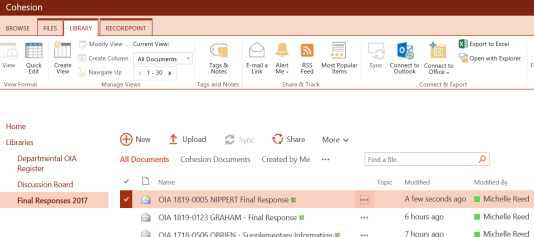

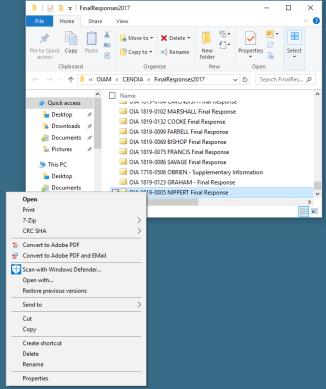
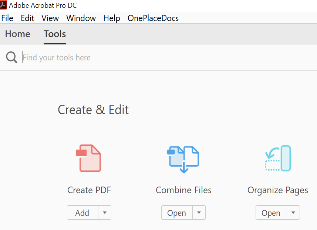
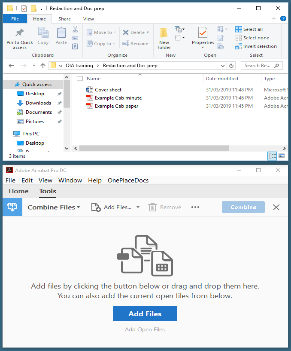 DIA document redaction and web standards processing handout
(accompanies training)
Preparing to redact in Adobe Pro DC
DIA document redaction and web standards processing handout
(accompanies training)
Preparing to redact in Adobe Pro DC
•
Open Adobe Pro DC
•
Select ‘Tools’ in the upper left hand corner of the screen.
•
Select ‘Combine files’
•
Open your file in file explorer in cohesion. (see next section for instructions on how to do this)
•
If you do not have access to file explorer in cohesionK (i.e. the icon displays as grey), you will need to save
your files to your desktop and drag and drop them into Adobe from there.
Opening files in Cohesion file explorer
•
Go to the location in cohesion where you have filed the documents you want to open in Adobe. In the
cohesion top row menu select ‘library’. Then, in the section 4 panel titled ‘Connect and Export’ select ‘Open
with Explorer’.
•
An explorer window should now open showing the files in that file folder. You should be able to double click
on PDF files to open in Adobe Pro DC, or drag and drop Word and PFD files from this window directly into
Adobe pro DC.
o If you are including outlook emails, you will need to convert this correspondence to PDF format
before you are able to enter it into Adobe.
o For a small quantity of correspondence – do this by right clicking on each email in turn in the
explorer window and selecting from the dropdown menu ‘Convert to Adobe PDF’.
under the Official Information Act 1982
o If you have a large quantity of correspondence, print all emails, order them chronologically and
scan the full set to yourself (producing one PDF file).
•
Drag and drop all PDF or word items into the Adobe pro window and rearrange them into the order you
would like them to display in in the final document.
Released
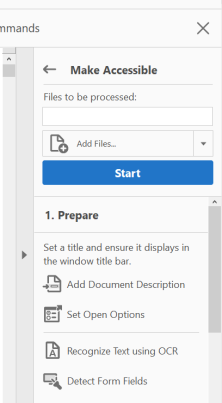
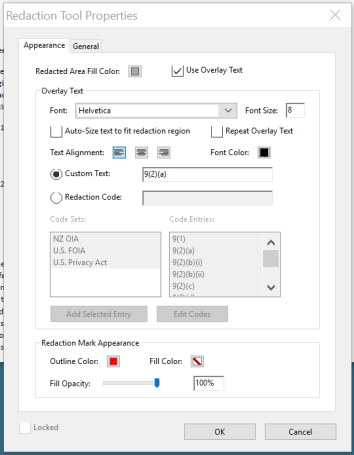
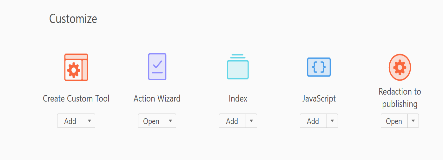



•
Select combine files at top right hand side of window. After documents are combined into ‘binder 1’, save the
file into your OIA request filing folder. Your name should include the label ‘- clean’.
Redacting in Adobe Pro DC
At this point you should have combined all documents you want to include into a single file and have the file open
in Adobe Pro DC.
Convert your file into a text recognised format.
•
Select Tools menu in the upper left hand corner of the screen.
•
Scroll down the tools menu screen to the ‘Customise’ section and select ‘Action Wizard’.
•
Select ‘Make Accessible’ in the right hand panel menu that will appear
•
Select ‘Recognise Text using OCR’ from the new right hand panel menu and then OK. (note there may be some
errors notified during the process due to logos and images. This is fine. Ignore them and continue.)
•
When the process has completed save your file.
Set the redaction appearance you want to use
•
Select Tools menu in the upper left of the screen
•
Scroll down the tools menu screen to the ‘Protect & Standardize’ section, and select ‘Redact’.
•
In the Redact tool’s top ribbon, select ‘Properties’.
•
In the Redaction Tool Properties menu:
under the Official Information Act 1982
o Ensure the ‘redacted area fill colour’ box is a mid-grey colour
o Decide if you will use overlay text to annotate your redactions.
o If you are using overlay text – ensure
▪ font is Helvetica,
Page 2 of 7
Released





▪ Font size is 8,
▪ text alignment is left,
▪ font colour is black.
o Enter your custom text e.g. 9(2)(a).
Note –you will need to return to the properties menu to change the custom text to annotate a
different section of the Act.
o In the bottom section ‘redaction mark appearance’ – select red as the outline colour. Fill colour
should be set to ‘no colour’.
o Select ‘Ok’
Mark up your redactions in the document
•
In the Redact Tool’s top ribbon, select ‘Mark for redaction’
and then ‘Text and images’ from the pulldown options that will appear.
•
Highlight over any text you want to mark for redaction.
•
You will see a red box now surrounds any text you have highlighted. If you hover over this area, the final
appearance of your redaction will display.
•
If you find you have made a mistake and want to undo any marked text, simply click on the marked text and
press delete. This will remove the redaction markup. It will not affect the text below the markup.
•
When you are satisfied all information to be withheld has
been marked up, save your document as a new name.
You should change the filename from ‘clean’ to ‘-markup’.
under the Official Information Act 1982
Complete your redactions in the document
You have used your markup document for consultation, and now your proposed withholding has been signed off
by your approver. You are ready to finalise your document.
Page 3 of 7
Released



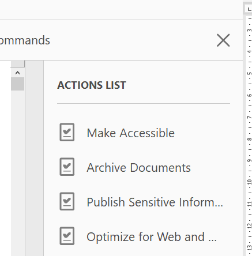
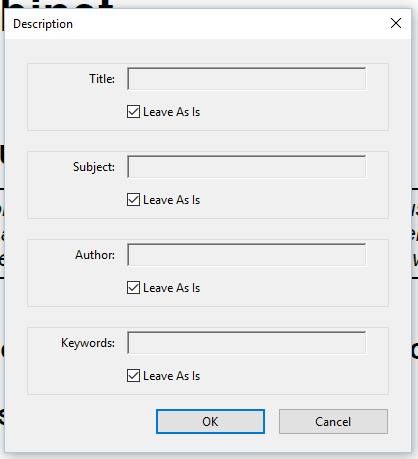
•
Select Tools menu in the upper left hand corner of the screen
•
Scroll down the tools menu screen to the ‘Protect & Standardize’ section, and select ‘Redact’.
•
In the Redact tool’s top ribbon, select ‘Apply’ and then OK.
•
After the redactions have been applied, a message window will pop up and ask if you would like to search for
hidden information. Select OK.
•
A panel will open on the left hand side and you will see Adobe searching your file. When it has finished, select
‘Remove’ and OK.
•
Now, in the Redact tool’s top ribbon, select ‘Sanitize Document’ and then OK.
•
Save your document as a new filename. You should change ‘-markup’ to ‘-redacted’.
Finalising the document for release
The redacted document is in a
safe format for release, however there are some finishing touches you must apply
before you can send it out.
Make your document screen-reader accessible
•
Select Tools menu in the upper left hand corner of the screen.
•
Scroll down the tools menu screen to the ‘Customise’ section and select ‘Action Wizard’.
•
Select ‘Make Accessible’ in the right hand panel menu that will appear. You are going to go through this
complete process this time.
•
Select ‘Start’ from the new right panel menu that appears.
under the Official Information Act 1982
o In the ‘Description’ window that pops up
▪ The Title of your document will be the Cabinet reference number for Cab papers, the OIA
reference number for OIAs. Never include the name of a person in this section.
▪ The Subject of your document will be a short summary of what the document is ‘about’. E.g.
Change to passport fees.
Page 4 of 7
Released



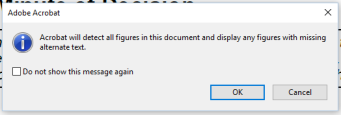
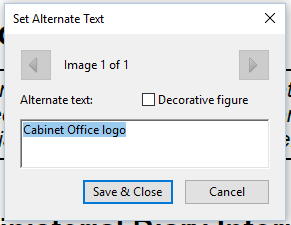



▪ The Author of your document will be ‘The Department of Internal Affairs’.
▪ Keywords might include Cabinet paper, OIA, or similar, along with subject words.
o In the ‘Recognise Text – General Settings’ window that pops up, click OK.
o In the fillable form window that pops up, click No, skip this step.
o In the ‘Set reading language’ window that pops up, click OK.
o A message box will pop up to tell you Adobe will detect all figures in the document. Click OK.
o In the ‘Set Alternate text’ window that pops up, after Adobe has finished checking, you are given
the option to enter text to explain what figures are.
▪ You will see something like ‘Image 1 of 20’ and a white text field below. This is where you
can enter your explanation of the figure. E.g. Cabinet Office logo.
▪ Press the arrows on left and right to tab through your figures and enter text for them.
▪ Note that Adobe will also pick up redacted areas as figures.
▪ When you have entered text for all of your figures, press OK.
o The next window will ask you if you want to complete an accessibility check. This is not needed.
You can click cancel.
Add bookmarks to your document
•
On the left hand side of the screen halfway down the page you will see a small arrow, indicating where you
can pull out the left side panel. Click this arrow.
•
Select the Bookmarks icon. (It looks like a ribbon).
•
Check that the bookmarks displayed in your document are appropriate.
under the Official Information Act 1982
o You can remove bookmarks by clicking on them and then pressing the rubbish bin icon
o You can add bookmarks by clicking on the place in the document that you want to bookmark and
then pressing the icon that looks like a ribbon with a plus sign
o If you double-click on any of the individual bookmarks, you can rewrite them.
Page 5 of 7
Released
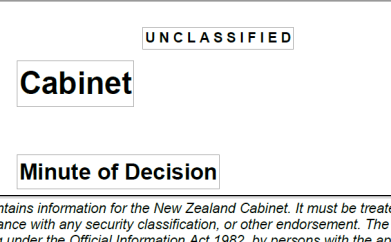
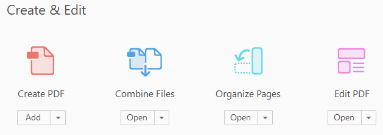


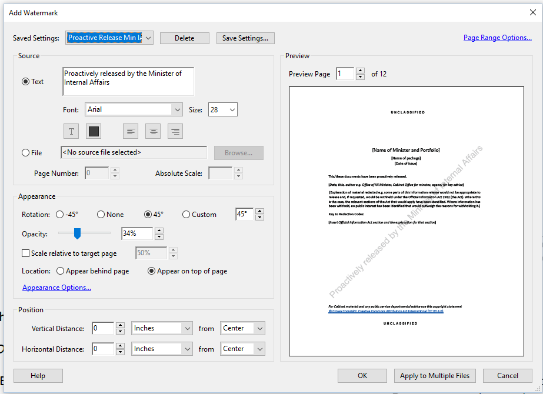 Consider changing security classifications in your document
Consider changing security classifications in your document
If your document is being proactively published on the DIA website, you should change the classifications marked
on the document to Unclassified.
•
Select Tools menu in the upper left hand corner of the screen.
•
Scroll down the tools menu screen to the ‘Create and Edit’ section and select ‘Edit PDF’.
•
Grey boxes will appear around all text sections in the document. Click on the classification boxes and rewrite
them (each) to state U N C L A S S I F I E D.
•
Remember to centre the text in the box.
Add a watermark to your document
•
Select Tools menu in the upper left hand corner of the screen.
•
Scroll down the tools menu screen to the ‘Create and Edit’ section and select ‘Edit PDF’.
•
In the Edit Tool’s top ribbon, select ‘Watermark’, and then ‘add’ from the pulldown menu that appears.
•
In the Add Watermark window that pops up:
o In the ‘source’ section
▪ text should read either e.g.
‘Proactively released by the Minister of Internal Affairs’ or
under the Official Information Act 1982
‘Proactively released by the Department of Internal Affairs’ or
‘Released under the Official Information Act 1982’
▪ Font should be Arial.
▪ Size should be 36 for an A4 page
Page 6 of 7
Released
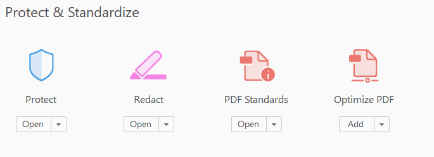

▪ Colour should be mid-grey for a proactive release and scarlet red for an OIA request
▪ Text should be centred
o In the ‘appearance section
▪ Rotation should be 45 degreees
▪ Opacity should be 35%
▪ Text should appear on top of page.
o Depending on the document being released, if you would like to remove the watermark from the top
page, you are able to do this in ‘page range options’ in the top right of the ‘Add Watermark’ window.
o Save your document. Your filename should include the label ‘release copy’
Reduce the file size of your document if necessary
•
Select Tools menu in the upper left hand corner of the screen.
•
Scroll down the tools menu screen to the ‘Protect & Standardize’ section and select ‘Optimize PDF’
•
In the Optimise PDF top ribbon, select ‘Reduce File Size’ and click OK to the message box that pops up.
Be aware that reducing filesize downsamples the quality of your file. You should never downsample the same
document more than once. You are able to downsample more than the standard measure suggested by
Adobe, but exercise caution in doing so. The objective is to end up with a releasable file. In some cases this
may mean that you need to release two files at good quality rather than one file at poor quality.
under the Official Information Act 1982
Page 7 of 7
Released
 UNCLASSIFIED
Privacy policy
Date approved
UNCLASSIFIED
Privacy policy
Date approved
4 October 2019
Review date
4 October 2020
Policy owner
Departmental Privacy Officer
Cohesion link
https://dia.cohesion.net.nz/Sites/GOV/DIAOrganisationalPolici
es/_layouts/15/DocIdRedir.aspx?ID=FUJSWU7TPTWC-
825107103-102
Policy overview
1.
This policy describes how the Department of Internal Affairs (DIA) will ensure that our
employees, partners, members of the public, and the Government retain the highest
level of confidence in our ability to safeguard the personal information we hold.
2.
DIA plays a privileged and trusted role as guardian of much of our nation's personal
information. Because of this role, we place privacy at the core of how we work for the
public. Our systems, processes, and practices provide a comprehensive and sound
platform for safeguarding personal information. Our people are expected to manage the
personal information we hold in a knowledgeable and respectful manner.
Audience and application
3.
The audience for this policy is all DIA employees.
4.
It applies to:
• All DIA employees. For the purposes of this policy all DIA staff includes permanent,
temporary and events-based staff members, as well as people contracted by or in a
business relationship with DIA, including volunteers and other unpaid positions;
• All information, regardless of medium, format or where it is stored, that has been
created or received in the course of business functions, processes, decision making,
under the Official Information Act 1982
actions and transactions;
• All business activities;
• Inter-agency initiatives where DIA is the lead agency or where it is agreed that DIA
owns or is responsible for the resulting information.
International application
Released
5.
DIA provides services to, and receives support from, a global community of customers,
employees, vendors, and partners. The prevalence of digital technology and online
services has led to considerable consumer awareness of how personal information is
managed. Many jurisdictions have sought to protect the rights of individuals by
enacting laws with extra-territorial application.
Cohesion reference: Organisational Policies/Information and Safety/Privacy Policy
Page 1 of 5
UNCLASSIFIED
6.
DIA operates offices in New Zealand, Australia, and the United Kingdom. The services
we offer are available online and accessible anywhere in the world.
7.
Laws outside New Zealand may have application to DIA and its management of personal
information. To manage the variations between the privacy protections mandated in the
jurisdictions we are located in and our domestic law, DIA has adopted this policy, which
applies international best practice for managing personal information and meets or
exceeds legislative requirements except where noted.
Delegated authorities
1982
8.
The delegated authorities that apply are set out in the Delegations policy.
Accountability
Act
9.
The Executive Leadership Team (ELT) is accountable for this policy.
Responsibilities
10. All DIA employees are responsible for protecting personal information entrusted to DIA.
11. ELT has the responsibility for ensuring DIA has appropriate policies and processes to
safeguard the personal information entrusted to us.
12. ELT are responsible for creating and nurturing a respectful privacy culture in DIA.
Information
13. Deputy Chief Executives are responsible for assuring the Chief Executive that their
Branches comply with DIA policies and processes to safeguard the personal information
it holds.
14. The Departmental Privacy Officer is responsible for monitoring DIA’s compliance with
legislative requirements and international best practice, and for advising ELT about any
Official
risks to our ability to protect and manage the personal information we hold.
Third party engagement the
15. DIA’s responsibility to manage personal information extends to include third parties
that DIA enters in to agreements with to share information or to supply services that
involve the management of personal information on behalf of DIA.
16. DIA will ensure that any potential third-party supplier is made aware of these obligations
under
in agreement terms and during the procurement processes, so that they can ensure they
have the appropriate measures in place to meet these obligations.
17. DIA will offer contract terms which will be available for all vendors and suppliers to
incorporate in to agreements to manage personal information on behalf of DIA.
18. DIA recognises many third parties will be aware of these obligations and will have
developed their own contract terms to address this. DIA will evaluate any such terms
when engaging in a business relationship with the third party to ensure the
Released
responsibilities of both parties are understood and agreed.
Page 2 of 5
UNCLASSIFIED
Detailed policy
Guiding principles
19. DIA’s management and protection of personal information will be guided by the
following principles:
• We will embody a culture in which personal information is protected and respected;
• Individuals can have confidence that DIA is a trusted guardian of their personal
information;
1982
• All personal information we hold will be managed and used in accordance with
international best practice and the legislative and regulatory obligations created in
Act
the jurisdictions in which we are located.
20. Our commitment to privacy will be shown by:
• Only collecting personal information which is necessary to undertake our functions;
• Being transparent and open about what personal information is being collected;
• Giving individuals the opportunity to make an informed choice about the personal
information they provide, or how much personal information they provide;
• Ensuring all individuals have the right to access personal information we hold about
them and the right to seek correction if that information is wrong;
Information
• Establishing a clear and lawful purpose for collecting personal information, and only
using and disclosing personal information in accordance with that purpose;
• Taking reasonable steps to make sure that personal information is accurate before
we use it;
• Protecting personal information from loss, misuse, and unauthorised access or
Official
disclosure;
• Responding quickly and appropriately if a privacy breach occurs or is suspected.
the
21. To achieve this DIA will:
• Implement best practice end-to-end privacy management processes. We will do this
by:
–
Embedding privacy by design principles into service design so that privacy
under
protection is at the forefront of systems and business processes.
–
Utilising privacy impact assessments in all new business process development
where personal information is involved.
–
Testing and auditing our current systems to actively identify risks to privacy
security and apply treatments when risks are identified.
• Ensure our employees are confident and knowledgeable in their approach to
managing personal information. We will do this by:
Released
–
Providing resources, training and guidance material on privacy practices.
–
Using our privacy communication strategy to focus and raise awareness of
privacy with our employees.
• Regularly assess the state of our privacy health. We will do this by:
–
Measuring DIA against the Privacy Maturity Assessment Framework.
Page 3 of 5
UNCLASSIFIED
–
Reviewing and refreshing our privacy programme to continually lift our
performance against all elements of the Privacy Maturity Assessment
Framework.
–
Monitoring how we manage privacy requests, complaints and breach
responses and implementing changes to our processes if deficiencies are
identified.
• Provide effective leadership on privacy across DIA. We will do this by:
–
Empowering our Departmental Privacy Officer to undertake effective
monitoring and oversight of our compliance with legislative requirements.
1982
–
Equipping our managers with privacy skill and knowledge so they can
effectively enable our staff and systems to protect individual privacy. Act
–
Establishing and utilising a network of privacy champions to provide guidance
and support to our branches.
Definitions
22. The following definitions apply when interpreting this policy:
•
Departmental Privacy Officer – the General Manager Information and Safety is the
Department’s designated Departmental Privacy Officer und
er s23 of the Privacy Act
1993. Their functions include:
Information
–
Encouraging compliance with legislative requirements and international best
practice.
–
Working with the Office of the Privacy Commissioner in relation to any
investigations the Privacy Commissioner may be undertaking.
•
Personal information – is any information held by the Department, in any format,
which is about an identified or identifiable individual.
Official
For the avoidance of doubt; this includes unique identifiers, location information,
biometric information, and aggregate or statistical information which has not been
the
anonymised or pseudonymised.
Legislation
23. This policy seeks to ensure DIA meets or exceeds the obligations created under the
following legislation:
under
•
New Zealand Privacy Act 1993
•
Australian Privacy Act 1988
•
The General Data Protection Regulation of the European Union
24. DIA recognises the potential for discrepancy in application between the above
legislation, and other Acts which amend or overwrite the obligations created therein. In
a scenario where DIA is unable to reconcile two competing requirements, we will
Released
prioritise the obligations under New Zealand law.
25. We note that there is likely to be such a discrepancy between the New Z
ealand Public
Records Act 2005 an
d Article 17 of the General Data Protection Regulation.
Page 4 of 5
UNCLASSIFIED
Related documents:
26. The following documents are relevant to this policy:
•
Privacy Maturity Assessment Framework
•
Delegations Policy
1982
Act
Information
Official
the
under
Released
Page 5 of 5
Document Outline







































